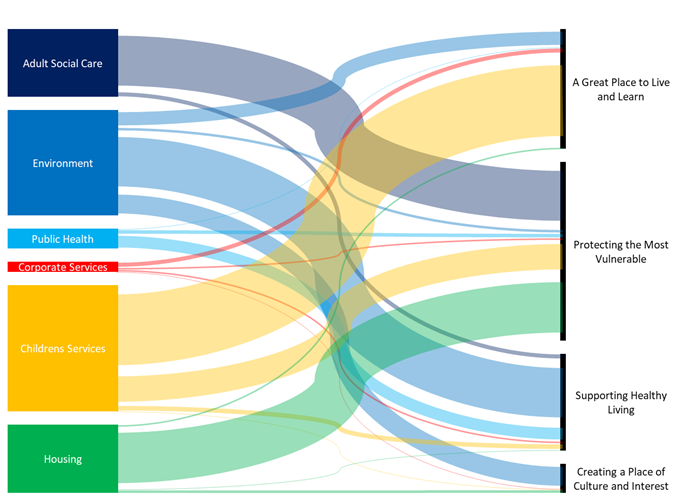The global pandemic has only exacerbated the continuing pressure faced by councils to balance budgets. With increased costs and reduced income, the need to better manage demand has become increasingly important – all whilst ultimately trying to achieve the best outcomes for our citizens.
Closing the financial gap and improving or maintaining outcomes requires both a shift towards prevention, and the need to take a more holistic system-wide approach to improving outcomes; looking at one process or directorate in isolation is not an effective way to achieve sustainable change in a complex system.
This raises the question: how confident are we that those collective investment decisions are effectively working towards a council’s outcomes?
We recently worked with one of our clients to map their revenue budget and activities against their priorities.
This resulted in a visual spend map to provide an alternative view of how money is allocated, show which outcomes the spend is geared towards, and enable discussions on whether the distribution of budget is right. Most importantly, it has enabled the council to:
- Identify opportunities to strengthen the preventative impact of spend (from creating dependence on council services to supporting independence) and increase return on investment. This may also include identifying gaps in need of investment.
- Deliver more effectively and efficiently through different models or approaches, and join up spend
- Identify areas of spend not aligned to priorities or where there is duplication or fragmentation in approach
- Provide Members with visibility of the distribution of resources against the council plan.
The results have been fascinating and have helped reframe conversations between cost centre managers, directors, and portfolio holders about how they can collectively work towards the council’s outcomes – rather than simply looking at directorate-focused transformation and savings initiatives.
The map below shows how a typical revenue budget, by directorate, can be classified against the priorities as set out in the council plan.

By analysing spend in this way, the tool places more focus on prevention and has prompted questions which may not have been asked before, such as:
- Have we got the right level of investment for each council priority or does there need to be some rebalancing, especially post-Covid?
- How can different directorates work more effectively with their budgets to achieve similar intended outcomes?
- How can different directorates better coordinate budgets focused on early intervention or supporting independence, to utilise them more effectively?
- How can different directorates better coordinate budgets for specific cohorts (such as vulnerable residents, business owners or learners) or specific ages, to utilise them more effectively?
- Do multiple cost centres across multiple directorates lead to uncoordinated decision making?
- Do resources support a preventative approach and is the balance sustainable in the long term?
- Is the impact of preventative spend understood and how does this inform delivery and commissioning?
Supply-side savings initiatives have run their course. Simply looking at managing controllable demand is no longer an effective means to maximise value for money. It is now more important than ever to consider spend more holistically in a complex system, to achieve better outcomes for less.
Over the coming months we will use the spend mapping tool to analyse the spend distribution of councils across England. If you would like to learn more, do get in touch.


